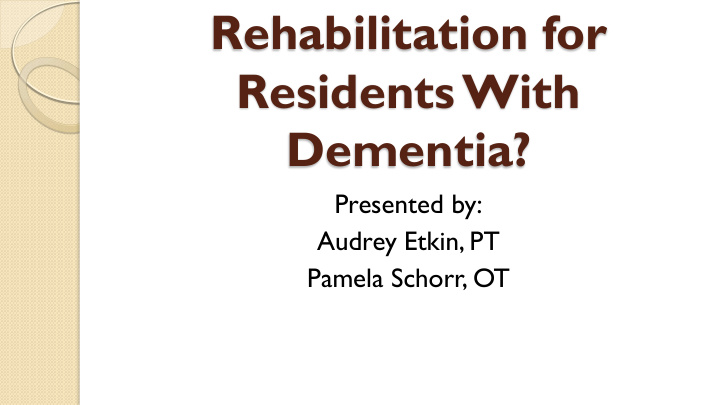



Rehabilitation for Residents With Dementia? Presented by: Audrey Etkin, PT Pamela Schorr, OT
What Is Dementia? ● A general term used to indicate a decline in mental ability severe enough to interfere with daily life ● Alzheimer's is the most common type of dementia making up 60-80% of the diagnosed dementia population
Staggering Statistics ● Alzheimer’s Disease is the sixth leading cause of death in the United States overall and the fifth leading cause of death in the over 65 population. ● More than 5 million Americans and an estimated 44 million people world- wide are living with Alzheimer’s. An American is diagnosed with Alzheimer’s Disease every 68 seconds. By the year 2050 researchers estimate this time frame to change to every 33 seconds. ● In 2013 Alzheimer’s cost the nation $203 billion and it is expected to rise to $1.2 trillion by 2050. This equates to a 500% increase in combined Medicare/Medicaid spending.
Fall Definition “Unintentionally coming to the ground, floor or other level.”
Fall Statistics in Elderly Adults ● Annually, falls among older adults are responsible for: Over 20,000 deaths 2.3 million emergency department visits More than $30 billion spent on medical intervention ● Approximately 20% of older adult falls cause serious injuries that limits mobility, diminish quality of life, and increases the risk of premature death. ● Two-thirds of those who experience a fall will fall again within 6 months ● Two-thirds of falls are preventable ● 25% of community-dwelling individuals over 75 years old restrict their activities because of a fear of falling
Fall Factors Most falls are not the result of random accidents but are the result of the presence of numerous risk factors and a compromised medical condition. T wo Main Risk Factors ● Extrinsic Factors ● Intrinsic Factors
Dementia Related Falls In addition to cognitive deficits, people with dementia experience declining basic motor performances, such as walking. Motor deficits worsen by the reduced physical activity and increase the fall risk in these patients. The annual incidence of falls in patients with dementia is three times the rate of the cognitively normal elderly population ( Tinetti et al., 1988). A recent study found impairments in gait and balance in 93% of patients with dementia who went to emergency departments following a fall.
Fall Prevention “Rehabilitation of basic functional tasks, such as the ability to rise from a chair or walking, is of utmost importance to reduce fall risk, prevent loss of independence, and increase mobility- related quality of life in patients with dementia.” Michael Schwenk, PHD, research associate, UA Interdisciplinary Consortium on Advanced Motion Performance, “Intensive Exercise Program Designed for Dementia Patients Improves Care.” Dementia Today, n.d., n.p. 12 January 2014.
How Does This Impact The Assisted Living Industry? With the aforementioned unimaginable statistics the time is NOW to ensure your community is equipped to meet the needs of this growing population. With appropriate intervention and staff education individuals with dementia can be maintained in the assisted living setting.
What is the Role of Physical & Occupational Therapy Build rapport and develop trust with residents Instruct staff Offer operational consulting as needed Marketing Work with Activities Department Collaboration of therapy with community staff, primary care physicians, and resident’s family Assist with retention of residents in the community Screen residents for fall risk Occupational and Physical Therapy Evaluation and Treatment
Benefits of Occupational & Physical Therapy Maximize independent function and mobility Increase strength Improve Activities of Daily Living Recommend adaptive equipment and assistive devices Fall Prevention Lift mood, ease stress, and add calm Improve general cardiovascular health
Traditional OT/PT Versus Engaging activities to achieve therapeutic outcomes
OUT OF THE BOX OT&PT IN TREATING PATIENTS WITH DEMENTIA
~ T estimonials ~
“My mom was the happiest she has ever been since meeting both of you. She never wanted to get out of bed until she came here. Now she’s up and on the go! She loves working with you and is so much healthier. Physical and Occupational therapy brought out the best in her.” DD “Thank you for rearranging my dad’s room and making it safer for him to move around.” SA “ I’m so very grateful you had the skills, knowledge and judgment to rehabilitate my mom after her pelvic fracture. Not all therapists have the tools to work with those who have dementia. It was a miracle.” PG “Before coming here my uncle fell all the time. I can’t believe that he now walks with a rolling walker and never falls.” SB “My brother and sister -in-law would not have been able to stay together had it not been for the assistance of the therapists.” FM
Conclusion and Questions
Recommend
More recommend